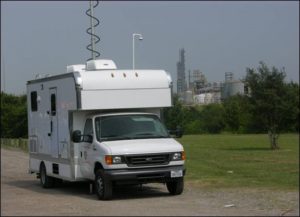Two new Mobile Laboratories coming to Houston Area
Both Harris County and the City of Houston acquired new vehicles to monitor Houston's Air
By Siena Corbin
Harris County, which is known for its massive population that continues to grow at a fast pace, needs to take huge steps to make sure that residents have clean air to breathe. Within the past two months, there has been a significant step in the right direction. The City of Houston’s Health Department has a new Mobile Ambient Air Monitoring Laboratory, also referred to as MAAML. This is the second mobile vehicle operated by the City, which is now better equipped to monitor air pollution on a day-to-day basis as well as during natural disasters or other unpredictable emergencies.
Compared to the city’s older model, this new laboratory has increases in mobility as well as speed in analyzing data. These mobile labs are designed to respond to citizen complaints as well as larger situations including a chemical plant or refinery fire.
The Centers for Disease Control and Prevention funded this equipment in hopes to better protect the health of residents. The city is also upgrading the original lab thanks to a grant from the Environmental Defense Fund. These actions will further increase air quality awareness in Houston.

Seeing progress like this gives hope that citizens are being heard in Texas. At a bare minimum, people need clean air to breathe. Polluted air in both urban and rural areas is becoming more and more of a safety issue, so preventative measures like this need to keep happening across the state and country. This new mobile monitoring lab is a notable change that the Houston Health Department has made to benefit the community, and the great news is that this kind of investment is becoming more prevalent.
Harris County also had exciting news recently regarding air quality monitoring. Last November, just a few months prior to the city’s unveil, the county acquired it’s own new mobile unit known as the RAAM. RAAM can detect a wide variety of compounds in real time allowing people to know what’s happening in the moment and not be delayed by lengthy lab analysis.
The RAAM unit can also be utilized for emergency response, along with MAAML and other technology, which creates a beneficial system of protection for communities in the area. The hope is that these units will begin a network of air quality monitors that work together to maximize abilities and area coverage.
This is good news especially for communities of color in the Houston area. They have a higher probability of living in areas of the city that have poorer air quality. The pollutants in these areas have proven to result in a higher cancer risk, and there are a disproportionate number of Black and Latino residents living in these areas.
Public Citizen’s own Stephanie Thomas commented on this issue stating, “It doesn’t matter what your income is, if you live in a community that is primarily people of color, you are likely going to be more exposed to pollution and that has big consequences. Across Harris County there is as much as a 23-year difference in life expectancy which is just shocking and no one’s life should be cut short because of the zip code they live in”. This enormous difference in life expectancy due to air pollution is a devastating statistic that calls for extreme measures.
But with RAAM and the newest addition of a second MAAML, these units should be able to provide detailed information on air quality in all areas of the county. These areas should then receive the appropriate reactions to inadequate data results. Taking action based on the data is what will create real change. Knowing the problems at hand, as well as the specific location of the issues, is a crucial first step.
Both Houston and Harris County are doing a good job of air monitoring for their citizens and we hope to see the momentum continue in the future.